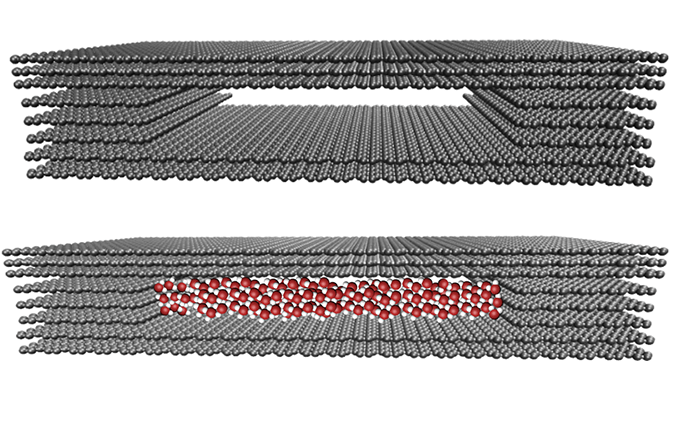Sep 9 2016
 (Credit: University of Manchester)
(Credit: University of Manchester)
Materials that contain cavities and small capillaries are used for separation, filtration, and various other technologies, and without such materials it would be impossible to lead a modern lifestyle.
Such materials are often found by accident or luck, and not by designs. The development of such artificial capillaries with atomic-scale precision has been an unimaginable concept.
A team of researchers from the University of Manchester, headed by Radha Boya and Nobel laureate Andre Geim, have developed a technique to make the impossible possible. They have discovered a technique to create the smallest ever gas and water pipes that are only one atom in size. The research has been published in the journal Nature.
This newly discovered technology is a kind of antipode of the revolutionary material graphene, and is unbelievably simple, adaptable and elegant. When making graphene, scotch tape is used to extract a single atomic plane of carbon atoms from a piece of graphite, and the remaining graphite is discarded.
In this study, Manchester scientists extracted a strip of graphene from graphite, but instead of focusing on graphene, they focused on the ultra-thin cavity that was left within the graphite crystal.
Various materials can be used to make atomic scale cavities that help to achieve the desired properties and desired size of capillary walls. They can be hydrophilic or hydrophobic, atomically smooth or rough, electrically charged or neutral, insulating or conductive, and so on.
To confine various substances, the voids can be made into cavities or even into open-ended tunnels to transport various liquids and gases. This transformation is of huge interest for fundamental research and many other applications.
Making something useful out of an empty space is certainly cute. Finding that this space offers so much of new science is flabbergasting.
Sir Andre Geim, Nobel Laureate, University of Manchester
At this truly atomic scale, the properties of materials are expected to be different from the common materials found in the macroscopic world. In order to prove that this variation is because of the atomic-scale voids, Manchester researchers tested the nature of flow of water through these ultra-narrow pipes.
It was found that water flowed with increased speed and with less friction, which looked as if the narrow channels were many thousands times wider than they actually are. This behavior of water through these ultra-narrow pipes surprised the researchers.
This is an entirely new type of nanoscale systems. Such capillaries were never imagined, even in theory. No one thought that this degree of accuracy in design could be possible. New filtration, desalination, gas separation technologies are kind of obvious directions but there are so many others to explore.
Radha Boya, Researcher, University of Manchester
Sir Andre added ‘Making something useful out of an empty space is certainly cute. Finding that this space offers so much of new science is flabbergasting. Even with hindsight, I did not expect the idea to work so well. There are myriads of possibilities for research and development, which now need to be looked at. We are stunned by the choice.’
This research was supported by the Royal Society, the European Research Council, and the Lloyd’s Register Foundation, a charitable foundation helping to protect property and life by lending support to engineering-related education, application of research, and public engagement.